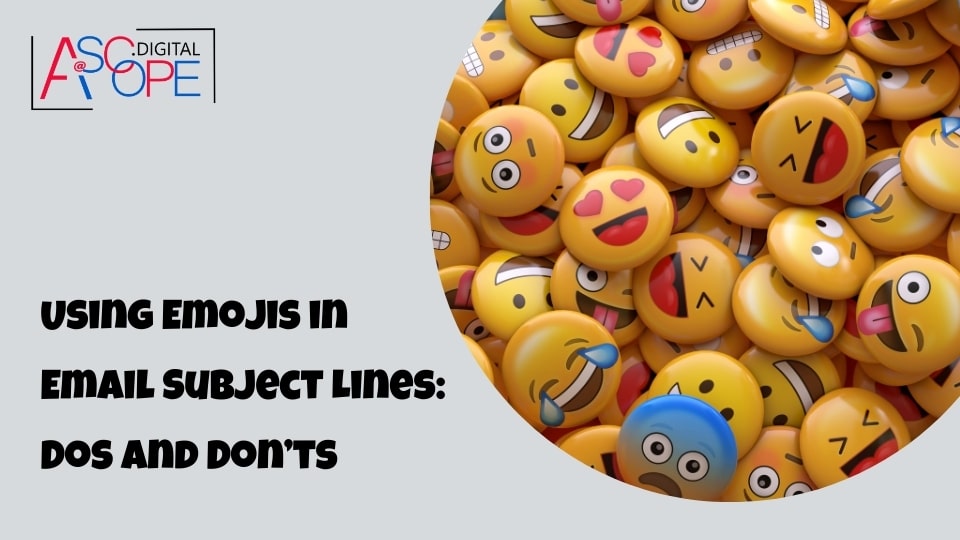The Psychology Behind Emojis in Email Subject Line
In the digital age, communication has evolved beyond text. Emojis, the small digital icons representing emotions, objects, and symbols, have become a significant part of our daily interactions. Their use extends beyond personal messages and social media posts, finding a crucial place in email marketing. Understanding the psychology behind emojis can help marketers harness their power to enhance email engagement and effectiveness.
Emotional Connection and Expression
At the core of human communication is emotion. Traditional text can sometimes fall short in conveying the full spectrum of human emotions. Emojis fill this gap by providing visual cues that text alone cannot. They offer a quick and effective way to express emotions, making the message more relatable and human. Using emojis in your Email Subject Line can significantly enhance this effect.
Research suggests that emojis can trigger emotional responses in recipients similar to those elicited by facial expressions in face-to-face interactions. For instance, a smiley face emoji 😊 in your Email Subject Line can evoke feelings of happiness and warmth, creating a positive association with the message. This emotional connection can lead to higher engagement rates, as recipients are more likely to open and respond to emails that resonate on an emotional level.
Visual Appeal and Cognitive Processing
Humans are inherently visual creatures. Our brains process visual information faster than text. Emojis, being visual elements, can capture attention quickly and effectively. In a crowded inbox, where dozens of emails compete for attention, an emoji can make an email subject line stand out.
The use of emojis in email subject line leverages this cognitive processing advantage. They break the monotony of text, adding color and visual interest. This not only makes the email more noticeable but also more memorable. Recipients are more likely to recall emails that stood out visually, increasing the chances of engagement and retention.
Conveying Tone and Intent
One of the challenges in written communication is conveying tone and intent accurately, especially in an email subject line. Misinterpretations can lead to confusion or even negative perceptions. Emojis help bridge this gap by providing contextual cues about the sender’s tone.
For example, an email subject line that reads “Big Sale Today!” can come across as either exciting or overly aggressive, depending on the reader’s interpretation. Adding a celebratory emoji 🎉 can clarify the intent, making it clear that the message is meant to be exciting and positive. This clarity can enhance the reader’s experience, reducing the likelihood of miscommunication.
Enhancing Relatability and Approachability
Brands often strive to appear relatable and approachable to their audience. Emojis can contribute to this by adding a human touch to the communication, especially in the email subject line. They can make a brand appear more friendly and less corporate, fostering a sense of familiarity and trust.
When used appropriately, emojis can make the brand’s voice more conversational. This conversational tone can make recipients feel as though they are interacting with a friend rather than a faceless entity. This perceived relationship can enhance brand loyalty and increase engagement rates.
The Psychological Principle of Novelty
Novelty plays a significant role in capturing attention, especially in the email subject line. The human brain is wired to notice new and unexpected stimuli. Emojis, when used judiciously, can provide this element of novelty. They can surprise and intrigue the recipient, prompting them to open the email out of curiosity.
However, it is crucial to balance novelty with relevance in the email subject line. Overuse of emojis can lead to desensitization, reducing their effectiveness. Marketers should aim to use emojis in a way that feels fresh and relevant to the message, maintaining their novelty appeal without appearing gimmicky.
The Impact of Cultural Differences
While emojis have universal appeal, their interpretation can vary across cultures. It is essential for marketers to be aware of these cultural nuances to avoid potential miscommunication. An emoji that conveys a positive message in one culture might have a different or even negative connotation in another.
For example, the thumbs-up emoji 👍 is generally seen as a positive gesture in many cultures but can be considered offensive in certain parts of the Middle East. Marketers should conduct thorough research and possibly A/B test with diverse audience segments to ensure that the emojis used are culturally appropriate and effective.
The Benefits of Using Emojis in Email Subject Line

Emojis, once a novelty of text messaging, have permeated various forms of digital communication, including email marketing. Their inclusion in email subject line can bring several benefits, enhancing the effectiveness of email campaigns. Understanding these benefits can help marketers leverage emojis to maximize engagement and deliver compelling messages.
Increasing Open Rates
One of the primary metrics of email marketing success is the open rate. The email subject line is the first impression an email makes, and its ability to capture attention directly impacts whether the email gets opened. Emojis can significantly boost open rates by making email subject line more eye-catching and engaging.
Research indicates that emails with emojis in the email subject line can experience higher open rates compared to those without. The visual element of an emoji can break the monotony of text, making the email stand out in a crowded inbox. This attention-grabbing quality can pique the recipient’s curiosity, encouraging them to open the email to see what it contains.
Conveying Emotion and Tone
Emojis are powerful tools for conveying emotion and tone, aspects that can be challenging to express through text alone. A single emoji can encapsulate an emotion or sentiment that might require several words to describe. This ability to convey nuanced emotions helps to set the tone for the email before it is even opened.
For instance, a heart emoji ❤️ can convey affection or excitement, while a clock emoji ⏰ can indicate urgency. By using emojis, marketers can quickly communicate the emotional context of their message, making it more relatable and appealing to recipients.
Enhancing Visual Appeal
In the digital age, visual content often outperforms text. Emojis add a visual element to email subject lines, enhancing their appeal. This visual interest can be particularly effective in making emails stand out, especially on mobile devices where screens are smaller, and subject lines are often truncated.
The colorful and familiar nature of emojis can draw the eye more effectively than plain text, making the email subject line more inviting. This increased visual appeal can lead to higher engagement rates, as recipients are more likely to open emails that catch their eye.
Adding Personality to Brand Communication
Emojis can infuse personality into brand communication, making it more relatable and engaging. In an era where consumers value authenticity, adding a human touch to emails can enhance brand perception. Emojis can make a brand’s voice seem more conversational and less formal, fostering a sense of connection with the audience.
For example, a travel company might use a plane emoji ✈️ to convey excitement about a new travel deal, making the communication feel more personal and enthusiastic. This approach can make recipients feel like they are interacting with a friend rather than a corporate entity, building trust and loyalty.
Highlighting Key Points
Emojis can be used strategically to highlight key points or themes within the subject line. This can help to communicate the email’s main message quickly and clearly. For instance, a gift emoji 🎁 in the subject line of a promotional email can immediately signal to the recipient that the email contains a special offer or deal.
By using emojis to emphasize important aspects of the subject line, marketers can ensure that the core message is conveyed even if the recipient only skims their inbox. This can increase the likelihood of the email being opened and the message being acted upon.
Saving Space and Increasing Clarity
Email subject line often have limited character space, especially on mobile devices. Emojis can convey complex ideas and emotions in a single character, allowing marketers to save space while still delivering a clear and compelling message. This can be particularly useful for creating concise email subject line that communicate the essential information effectively.
For example, a sun emoji ☀️ can convey the idea of summer or good weather, allowing marketers to craft shorter and more impactful email subject line. This economy of space can help ensure that the entire email subject line is visible on all devices, increasing its effectiveness.
Creating a Sense of Urgency or Exclusivity
Emojis can be used to create a sense of urgency or exclusivity, driving recipients to take immediate action. Emojis like the alarm clock ⏰ or the fire 🔥 can convey urgency, prompting recipients to open the email quickly to avoid missing out on a limited-time offer.
Similarly, using emojis that suggest exclusivity, such as a VIP badge 🏅, can make recipients feel special and valued, increasing their likelihood of engaging with the email. This psychological trigger can be particularly effective in driving conversions and achieving marketing goals.
When to Use Emojis: Understanding Context and Audience

Emojis have become a staple in digital communication, but their effectiveness in email marketing hinges on understanding the right context and audience. While emojis can enhance engagement and convey emotions, their impact varies based on the situation and the recipients. Knowing when to use emojis and tailoring their use to your audience can make a significant difference in your email marketing success.
Knowing Your Audience
The first step in determining when to use emojis is understanding your audience. Different demographics respond to emojis in varied ways. Younger audiences, particularly Millennials and Generation Z, tend to be more receptive to emojis, viewing them as a natural part of digital communication. On the other hand, older demographics may perceive emojis as unprofessional or inappropriate in certain contexts.
Conducting audience research is crucial. Analyze your subscriber data to identify the age groups, gender, and cultural backgrounds of your audience. Segment your email list accordingly, and tailor your use of emojis to match the preferences of each segment. For instance, an email campaign targeting a younger audience might include more playful and expressive emojis, while a campaign aimed at a professional audience might use emojis more sparingly and thoughtfully.
Aligning with Brand Voice and Tone
Your brand’s voice and tone should guide your use of emojis. If your brand personality is casual, friendly, and fun, incorporating emojis can enhance your communication and make it more relatable. For example, a lifestyle brand targeting a young, vibrant audience can use emojis to reflect its playful and energetic tone.
Conversely, if your brand maintains a formal, professional image, using emojis may not align with your communication style. Financial institutions, law firms, and other businesses that operate in more serious sectors should be cautious with emoji use. However, even in these industries, there are occasions where a well-placed emoji can add a touch of warmth and humanize the brand without compromising professionalism.
Considering the Email Content and Purpose
The content and purpose of your email play a significant role in deciding whether to use emojis. Promotional emails, newsletters, and announcements about events or special offers are typically more suitable for emojis. These types of emails benefit from the added visual appeal and emotional resonance that emojis provide.
For example, a promotional email announcing a sale can use a shopping bag emoji 🛍️ to emphasize the shopping theme and attract attention. Similarly, an email inviting subscribers to a webinar can include a calendar emoji 📅 to highlight the event date.
However, for more serious or sensitive topics, such as customer service issues, formal announcements, or legal matters, it’s best to avoid emojis. In these contexts, emojis can undermine the seriousness of the message and detract from its credibility. Always consider the nature of your content and whether an emoji enhances or detracts from the intended message.
Testing and Analyzing Results
Testing is an essential component of effective email marketing. A/B testing can help you determine the impact of emojis on your email campaigns. Create two versions of your email subject line—one with an emoji and one without—and analyze the open rates, click-through rates, and overall engagement for each version.
This data-driven approach allows you to make informed decisions about when and how to use emojis. It’s important to test different types of emojis and placements as well. For example, placing an emoji at the beginning of a email subject line might have a different impact than placing it at the end. By experimenting with various scenarios, you can identify the most effective strategies for your audience.
Cultural Sensitivity and Global Audiences
Emojis can be interpreted differently across cultures. What is considered positive and friendly in one culture might have a completely different meaning in another. For instance, the thumbs-up emoji 👍 is generally seen as a positive gesture in many Western cultures, but it can be offensive in parts of the Middle East.
When marketing to a global audience, it’s crucial to be aware of these cultural nuances. Conduct research to understand how different emojis are perceived in various regions. If your email list includes subscribers from diverse cultural backgrounds, consider creating region-specific email campaigns with emojis that are culturally appropriate and effective.
Frequency and Overuse
While emojis can enhance engagement, overusing them can have the opposite effect. Bombarding your audience with too many emojis can make your emails look unprofessional and cluttered. It can also lead to emoji fatigue, where recipients become desensitized to their presence and less likely to engage.
Aim for a balanced approach. Use emojis strategically to highlight key points, convey emotions, or add visual interest, but avoid using them in every email or email subject line. Monitor your email metrics to ensure that your use of emojis is driving positive results and adjust your strategy if you notice a decline in engagement.
The Dos: Best Practices for Emoji Use

Using emojis in email subject line can enhance engagement, convey emotions, and make your messages stand out in crowded inboxes. However, to reap these benefits, it’s essential to follow best practices for emoji use. Here are key strategies to ensure your emojis have the desired impact without compromising your message’s clarity and professionalism.
Do Know Your Audience
Understanding your audience is crucial for effective emoji use. Different demographics and audience segments may respond differently to emojis. Younger audiences, such as Millennials and Generation Z, tend to be more receptive to emojis, while older demographics might view them as unprofessional.
Audience Segmentation:
- Conduct research to understand the preferences of different segments within your audience.
- Use emojis more liberally with younger, tech-savvy audiences.
- Be more conservative with older, professional, or formal audience segments.
Example: A fashion retailer targeting young adults can use trendy and playful emojis in their email subject line, such as “💃 Dance into Summer with Our New Collection!” Conversely, a financial services firm might use emojis sparingly or opt for more neutral icons.
Do Keep It Relevant
Emojis should complement and enhance the message of your email, not distract from it. Ensure that the emojis you choose are relevant to the content of your email and help convey the intended emotion or theme.
Relevance and Context:
- Select emojis that align with the subject matter and tone of your email.
- Avoid using emojis that could be misinterpreted or seem out of place.
Example: For a travel agency promoting a summer vacation package, a sun emoji ☀️ or a beach umbrella emoji ⛱️ would be appropriate and enhance the message. However, using a random emoji like a ghost 👻 might confuse recipients.
Do Test and Analyze
A/B testing is essential for optimizing your emoji use. Test different subject lines with and without emojis to determine which performs better in terms of open rates, click-through rates, and overall engagement.
Testing Strategies:
- Create multiple versions of your email subject line and test them on small segments of your email list.
- Analyze the performance data to identify the most effective use of emojis.
Example: A retailer might test two email subject line: “🎉 Big Sale Starts Now!” versus “Big Sale Starts Now!” By comparing the results, they can determine if the emoji positively impacts open rates.
Do Use Emojis to Enhance Clarity
Emojis can help clarify the tone and intent of your message, reducing the risk of misinterpretation. Use emojis to emphasize key points and convey emotions that might be difficult to express through text alone.
Clarity and Tone:
- Use emojis to highlight important information or calls to action.
- Ensure the emoji choice aligns with the desired tone of your message.
Example: An email with the email subject line “Important Update: Your Subscription Renewal 📝” can use the notepad emoji to indicate a formal update, making it clear that the email contains essential information.
Do Keep It Simple
Simplicity is key when using emojis. Overloading your subject line with too many emojis can make it look cluttered and unprofessional. Aim for a balanced and straightforward approach.
Simplicity:
- Limit the number of emojis to one or two per email subject line.
- Ensure that the subject line remains easy to read and understand.
Example: Instead of “🎉🎈🎁 Big Birthday Sale – Don’t Miss Out! 🎉🎈🎁,” opt for a simpler “🎉 Big Birthday Sale – Don’t Miss Out!”
Do Consider Cultural Differences
Emojis can have different meanings in different cultures. Be aware of cultural sensitivities and ensure that your emojis are appropriate for your global audience.
Cultural Sensitivity:
- Research the cultural connotations of emojis in different regions.
- Avoid emojis that could be misinterpreted or offensive in certain cultures.
Example: While the thumbs-up emoji 👍 is generally positive in many Western cultures, it can be offensive in parts of the Middle East. Choose emojis that have a universally positive or neutral meaning to avoid cultural misunderstandings.
Do Monitor Trends
Emojis, like any other aspect of digital communication, evolve over time. Stay updated on the latest emoji trends and usage patterns to keep your email marketing fresh and relevant.
Staying Current:
- Follow industry blogs and reports on digital communication trends.
- Experiment with new and popular emojis to see how they resonate with your audience.
Example: If a new emoji becomes popular, such as the fire emoji 🔥 symbolizing something exciting or trendy, consider incorporating it into relevant email campaigns to capitalize on its current popularity.
The Don’ts: Common Mistakes to Avoid

Using emojis in email subject line can be highly effective, but there are pitfalls to avoid to ensure your messages are clear, professional, and engaging. Here are some common mistakes to avoid when incorporating emojis into your email marketing strategy.
Don’t Overuse Emojis
One of the most common mistakes is overloading email subject line with emojis. While emojis can enhance your message, using too many can make your subject line look cluttered and unprofessional. Overuse can also lead to emoji fatigue, where recipients become desensitized and less responsive.
Avoid Clutter:
- Limit the use of emojis to one or two per email subject line.
- Ensure that the text remains the primary focus and that emojis complement rather than dominate the message.
Example: Instead of “🎉🎈🎁 Big Birthday Sale – Don’t Miss Out! 🎉🎈🎁,” use “🎉 Big Birthday Sale – Don’t Miss Out!” This keeps the subject line clear and impactful without overwhelming the recipient.
Don’t Use Irrelevant Emojis
Emojis should be relevant to the content of your email and the message you want to convey. Using emojis that do not align with your message can confuse recipients and detract from your email’s effectiveness.
Stay Relevant:
- Choose emojis that enhance and clarify your message.
- Avoid using emojis simply for the sake of using them.
Example: For a travel agency promoting a summer vacation package, a sun emoji ☀️ or beach umbrella emoji ⛱️ would be relevant. Using a ghost emoji 👻, however, would be confusing and off-topic.
Don’t Ignore Cultural Differences
Emojis can have different meanings in different cultures, and what is considered positive in one culture might be offensive in another. Ignoring these cultural nuances can lead to misunderstandings and potentially alienate segments of your audience.
Be Culturally Aware:
- Research the cultural connotations of emojis in the regions where your audience is located.
- Avoid emojis that could be misinterpreted or are culturally sensitive.
Example: The thumbs-up emoji 👍 is generally positive in many Western cultures but can be offensive in parts of the Middle East. When marketing to a global audience, it’s essential to choose emojis that have universally positive or neutral meanings.
Don’t Replace Text with Emojis
While emojis can enhance your message, they should not replace important text. Email subject line should remain clear and understandable even if the emojis are removed or not displayed properly.
Maintain Clarity:
- Ensure that the subject line communicates the key message without relying solely on emojis.
- Use emojis to complement and highlight text, not replace it.
Example: A email subject line that reads “💼🚀🌍” might be intriguing, but it’s unclear. Instead, use “Launch Your Career Worldwide 🌍” to ensure the message is clear, with the emoji adding a visual element.
Don’t Use Ambiguous Emojis
Emojis can sometimes have multiple interpretations. Using ambiguous emojis can lead to misinterpretation and confusion among recipients.
Choose Clear Emojis:
- Select emojis with clear and widely understood meanings.
- Avoid using emojis that might be interpreted in different ways.
Example: The folded hands emoji 🙏 can be interpreted as praying, thanking, or a high-five. To avoid ambiguity, choose an emoji that clearly conveys your intended meaning, like using a thumbs-up 👍 for approval or a heart ❤️ for appreciation.
Don’t Ignore Email Client Compatibility
Not all email clients display emojis the same way. Some may not display certain emojis at all, or they might render them differently, which can affect how your email subject line appears to recipients.
Check Compatibility:
- Test your emails across different email clients to ensure emojis are displayed correctly.
- Use common emojis that have broad support across major email clients.
Example: An emoji that looks great on an iPhone might not display correctly on an older Android device or a desktop email client. Testing ensures that your subject lines look good for all recipients.
Don’t Neglect Testing and Analysis
Assuming that emojis will always enhance your email performance without testing is a mistake. It’s essential to test different email subject line to determine what works best for your audience.
Conduct A/B Testing:
- Create different versions of your email subject line, with and without emojis.
- Analyze open rates, click-through rates, and overall engagement to determine effectiveness.
Example: Test a email subject line with an emoji “🎉 Big Sale Starts Now!” against a version without “Big Sale Starts Now!” Analyze the results to see which version performs better, and adjust your strategy accordingly.
Don’t Use Emojis in Sensitive or Formal Communications
Emojis are generally informal and can undermine the seriousness of certain messages. Using them in sensitive, formal, or professional communications can appear unprofessional and inappropriate.
Match Tone to Content:
- Avoid emojis in emails that address serious topics, customer complaints, or formal announcements.
- Use a professional tone that matches the gravity of the content.
Example: In a customer service email addressing a complaint, avoid using emojis like “We apologize for the inconvenience you experienced. 😔” Instead, maintain a formal tone: “We apologize for the inconvenience you experienced and are here to resolve the issue promptly.”
Testing and Measuring the Impact of Emojis

Incorporating emojis into email subject line can significantly impact open rates and overall engagement, but their effectiveness can vary depending on numerous factors. To maximize the benefits of emojis in your email marketing strategy, it’s essential to rigorously test and measure their impact. This process involves a combination of A/B testing, analyzing key metrics, and adjusting your approach based on data-driven insights.
The Importance of A/B Testing
A/B testing, or split testing, is a fundamental technique for understanding how different versions of your email subject line perform. By creating two versions of a subject line—one with an emoji and one without—you can directly compare their effectiveness.
Steps for A/B Testing:
- Define Your Objective: Determine what you want to measure (e.g., open rates, click-through rates, conversion rates).
- Create Variations: Develop two or more versions of your subject line, varying the use of emojis.
- Select a Sample Size: Choose a representative sample from your email list to ensure statistically significant results.
- Distribute Emails: Send the different versions to your selected sample groups simultaneously to minimize time-based biases.
- Analyze Results: Compare the performance metrics of each version to identify which one resonates best with your audience.
Example: A retailer might test two email subject line: “🎉 Big Sale Starts Now!” versus “Big Sale Starts Now!” By comparing open rates, they can determine if the emoji version is more effective in grabbing attention.
Key Metrics to Analyze
When testing the impact of emojis in your email subject line, focus on the following key metrics to gauge their effectiveness:
- 1. Open Rates: This metric indicates the percentage of recipients who open your email. Higher open rates for subject lines with emojis suggest that the emoji is effective in capturing attention.
- 2. Click-Through Rates (CTR): This metric measures the percentage of recipients who click on a link within your email. A higher CTR can indicate that the email subject line with emojis not only captures attention but also drives engagement.
- 3. Conversion Rates: This metric tracks the percentage of recipients who complete a desired action, such as making a purchase or signing up for a webinar. High conversion rates indicate that the email subject line with emojis effectively drives desired outcomes.
- 4. Unsubscribe Rates: Monitor the percentage of recipients who unsubscribe after receiving emails with emojis. A spike in unsubscribe rates might indicate that emojis are perceived negatively by your audience.
- 5. Spam Complaints: Track the number of recipients who mark your email as spam. Higher spam complaints for emails with emojis could suggest that the emojis are viewed as unprofessional or intrusive.
Interpreting Results and Adjusting Strategy
Once you have collected and analyzed the data from your A/B tests, the next step is to interpret the results and adjust your strategy accordingly. Here’s how to do it effectively:
- Identify Trends: Look for patterns in the data. For example, if emails with emojis consistently show higher open rates but lower CTRs, it might indicate that while emojis attract attention, they do not necessarily drive engagement.
- Understand Context: Consider the context of your emails. Emojis might work well for promotional emails but not for transactional or informational emails. Adjust your use of emojis based on the type of email and its purpose.
- Audience Segmentation: Analyze how different segments of your audience respond to emojis. Younger audiences might respond positively to emojis, while older, more professional segments might not. Tailor your emoji usage to different segments for maximum impact.
- Frequency of Use: Avoid overusing emojis. Even if they are effective in certain scenarios, using them too frequently can lead to diminishing returns or audience fatigue. Strike a balance to maintain their novelty and impact.
- Iterate and Optimize: Email marketing is an ongoing process. Continuously test new email subject line and emojis to keep your approach fresh and relevant. Use the insights gained from each test to refine your strategy and optimize performance.
Example: After testing several email subject line, a travel company might find that emojis like ✈️ and 🌴 perform well for vacation promotions but have no significant impact on business travel offers. They can then focus their emoji use on leisure travel emails while maintaining a more professional tone for business-related communications.
Tools and Platforms for Testing
Various tools and platforms can facilitate A/B testing and provide detailed analytics for measuring the impact of emojis in your email subject line:
- Email Marketing Platforms: Services like Mailchimp, Constant Contact, and Campaign Monitor offer built-in A/B testing features and analytics, making it easy to test different email subject line and measure their performance.
- Analytics Tools: Google Analytics and other analytics platforms can help track conversion rates and other key metrics, providing a comprehensive view of how your emails perform beyond just open rates.
- Surveys and Feedback: Direct feedback from your audience through surveys can provide qualitative insights into how they perceive emojis in your emails. This can complement quantitative data from A/B tests and help refine your strategy.
Cultural Considerations: Emojis and Global Audiences

Emojis have become a universal language in digital communication, transcending linguistic barriers and adding emotional depth to messages. However, their interpretation can vary significantly across different cultures. For email marketers aiming to engage a global audience, understanding these cultural nuances is crucial. Misinterpreting or misusing emojis can lead to misunderstandings or even offend recipients. Here’s a comprehensive look at cultural considerations when using emojis in email marketing.
Understanding Cultural Differences
Emojis are not universally understood in the same way. Cultural context plays a significant role in how these symbols are interpreted. What might be a positive gesture in one culture could be offensive or confusing in another.
Positive vs. Negative Connotations:
- Thumbs-Up Emoji 👍: In many Western cultures, this emoji is seen as a sign of approval or agreement. However, in parts of the Middle East and South America, it can be interpreted as a rude or offensive gesture.
- OK Hand Emoji 👌: Commonly used to indicate that everything is fine, this emoji can be offensive in Brazil, where it has a vulgar connotation.
Example: A company sending a global email campaign might use the thumbs-up emoji to convey approval. While recipients in the US might understand it positively, those in Iran might take offense. To avoid this, it’s crucial to research and understand the cultural connotations of emojis in your target markets.
Tailoring Emojis to Different Regions
To effectively use emojis in a global email campaign, it’s important to tailor your emoji use to different regions. This requires a deep understanding of your audience’s cultural backgrounds and preferences.
Conduct Cultural Research:
- Research how emojis are perceived in different countries and regions.
- Use resources such as cultural guides, local experts, and market research to gather insights.
Segment Your Audience:
- Segment your email list by geographic regions to customize your emoji use.
- Create region-specific email campaigns that respect cultural sensitivities and preferences.
Example: A global e-commerce brand could segment its email list by regions such as North America, Europe, and Asia. For each segment, they could tailor their use of emojis to align with local cultural norms and avoid potential misunderstandings.
Emojis in Business and Formal Contexts
Emoji Meanings and Variations
Even when the same emoji is used, its meaning can vary based on cultural context. Additionally, the appearance of emojis can differ across devices and platforms, which can affect how they are perceived.
Platform Differences:
- Emojis can look different on iOS, Android, and Windows devices. Ensure that your chosen emojis convey the intended meaning across all platforms.
- Test how emojis appear in different email clients and devices to maintain consistency.
Cultural Nuances:
- Some emojis have different meanings in different cultures. For instance, the folded hands emoji 🙏 is often used to represent prayer or gratitude in Western cultures but can also mean “thank you” or “please” in Japan.
Example: A hospitality brand using the folded hands emoji to thank customers might be interpreted as a sign of gratitude in the US, while in Japan, it could be seen as a formal way of saying “please” or “thank you.” Understanding these nuances ensures that your message is received as intended.
Best Practices for Global Emoji Use
To navigate the complexities of using emojis in global email marketing and crafting an engaging email subject line, follow these best practices:
- Research and Understand Cultural Contexts: Invest time in understanding the cultural backgrounds of your audience. Use reliable resources to gather insights into local customs and emoji interpretations to ensure your email subject lines are both appealing and appropriate.
- Test Emojis Across Different Segments: Conduct A/B tests with different emojis in various regions to gauge reactions. Use the data to refine your approach and choose emojis that resonate positively with each segment, enhancing the effectiveness of your email subject lines.
- Seek Local Expertise: Collaborate with local experts or cultural consultants who can provide guidance on appropriate emoji use. Consider localizing your email content, including emojis, to ensure cultural relevance, which can significantly impact the effectiveness of your email subject lines.
- Be Mindful of Formality: Adjust the formality of your emojis based on the context and audience. In formal or professional emails, use emojis sparingly and choose ones that align with the business tone to maintain the appropriateness of your email subject lines.
- Monitor and Adapt: Continuously monitor the performance and reception of your emails. Be prepared to adapt your strategy based on feedback and evolving cultural trends, ensuring your email subject lines remain effective and engaging.
Example: A multinational corporation could employ a local marketing team in each region to oversee email campaigns. These teams can provide insights into local preferences and ensure that emojis used in email subject line and content are culturally appropriate.


